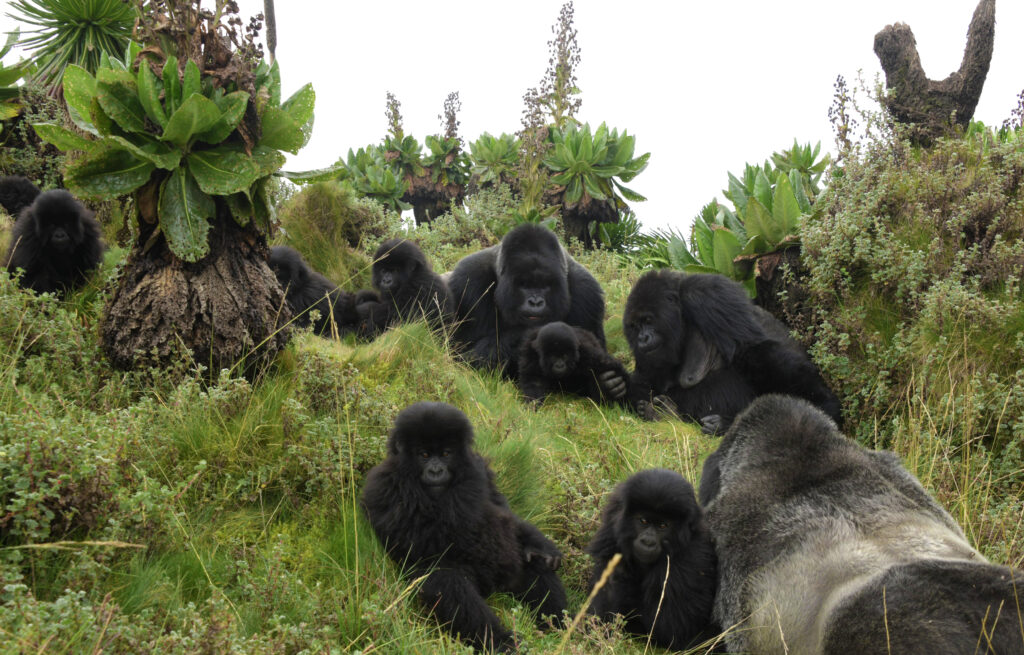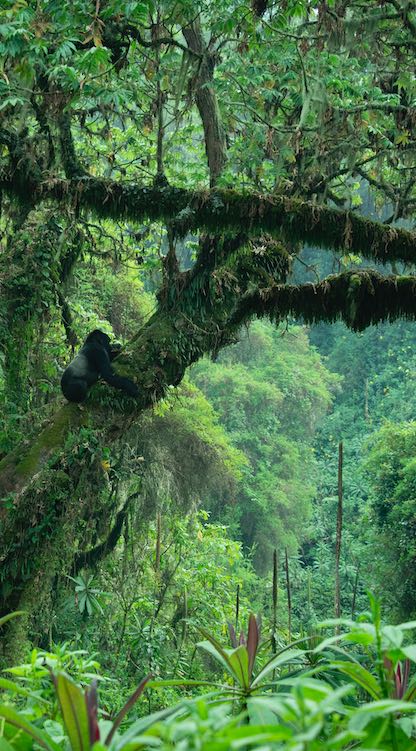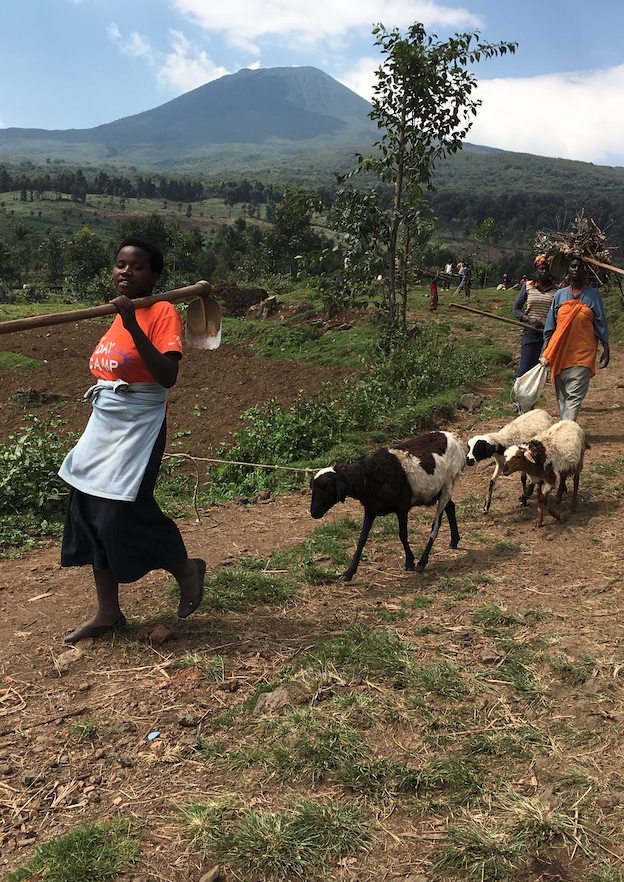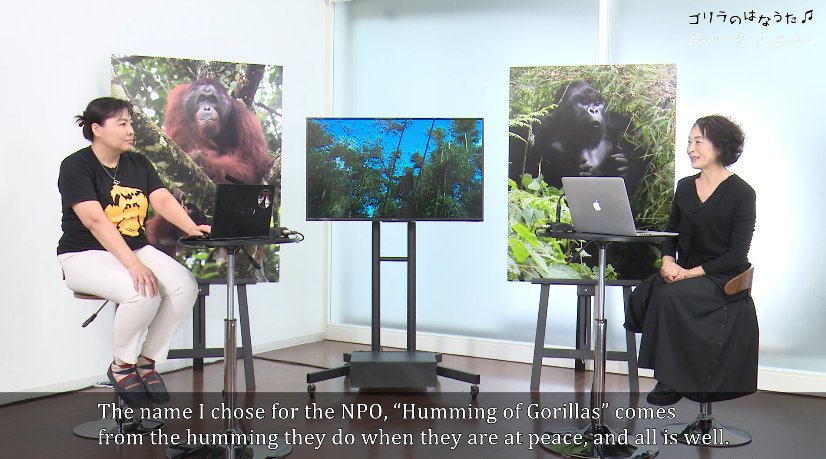Keiko Mori, our president, has been filming gorillas in Rwanda’s Volcanoes National Park since 2008. Through this activity, she has built a relationship of trust with the Rwanda Development Board of the Rwanda Government and Volcanoes National Park, and has sought ways to help those who are striving to protect gorillas on a daily basis. All of the local projects we are about to undertake are the result of discussions with RDB officers, and are the ones most needed in the field right now.
1. Strengthening and supporting the gorilla monitoring system

In order to protect gorillas appropriately, it is important to constantly understand their situation, but the system is still insufficient in Volcanoes National Park and support is needed. We will support both the hard aspect of improving equipment and the soft aspect of changing people’s attitudes.
Purchase of high-performance walkie-talkies
Walkie-talkies are essential tools for trackers in the forest to communicate with the park office and carry out their daily work smoothly, but currently there are only a few usable walkie-talkies, so park guides and trackers are forced to enter the forest without one on a daily basis. The government is considering purchasing a high-performance model that is useful for monitoring and equipped with GPS and can track and record location information and send and receive text messages, but there are still not enough of them. We will purchase 10 walkie-talkies of the same model and donate them to the national park.
Photography skills training for trackers
In order to improve the motivation of trackers, who are responsible for tracking gorillas daily and observing and recording their behavior, and to improve the accuracy of individual identification, we encourage them to carry cameras and take pictures of gorillas themselves. When identifying individual gorillas, the wrinkles on their noses (nose prints) are one of the indicators, so we aim to have trackers learn not only the basic operations required for photography, but also the points to take good pictures of nose prints, so that all trackers will become excellent observers and be able to record accurately. We will donate cameras, computers, and printers to the park and also hold skills training sessions.
Gorilla Family Cards
As an ongoing initiative, we have created “family cards” (A3 size) that include the names and photos of each of the 21 gorilla groups, as well as the relationships between the individuals, on a single card, and update them twice a year. These cards are used not only by park guides to identify the individuals of each gorilla group and learn their composition, but also to explain to tourists about the gorilla groups they are going to observe in advance. By correctly understanding the relationships between individuals, visitors can gain a deeper understanding of the meaning and background of each individual’s behavior.
Oral traditions by senior trackers
The memories of senior trackers who have retired are filled with records of the many years they spent watching gorillas and in the forest. We will record their stories on video, including the personalities and behavior of various gorillas, changes in the composition of groups, and changes in the forest, so that they can pass on their rich knowledge to the next generation.
2. Provision of alcohol-based disinfectant gel to prevent infection

Gorillas are primates, and special attention must be paid to zoonosis. There are about 1,000 gorillas living in the Virunga volcanic belt, which spans three countries including Rwanda. If infection spreads to this population, the impact will be devastating.
In the past, thousands of gorillas in northern Congo died from Ebola hemorrhagic fever, a zoonotic disease. Recently, Ebola hemorrhagic fever broke out in the Democratic Republic of Congo. It took more than two years to end. The new coronavirus infection that is currently raging around the world is also a zoonotic disease, and Rwanda banned tourists from entering the volcano park where gorillas live for three months from March 2020.
In light of this situation, in order to prevent infection from humans to gorillas, all tourists and park staff entering the park will be encouraged to disinfect their hands with alcohol. Alcohol gel will be placed in the park office and the ranger’s station in the forest.
3. Awareness-raising activities in Rwanda

Volcanoes National Park is considering plans to expand the park in the future. This is an ambitious plan to gradually relocate the 18,000 residents in the area while providing them with a better living environment, and to restore the current agricultural land as forest where gorillas can live. In order to smoothly proceed with this plan, it is essential to have the understanding of the local residents who will be relocated.
Currently, the relationship between the national park and the local residents is good, and they are understanding of the plan, but it is particularly important that the children who will support this area in the future have a deep understanding of the forest ecosystem and the situation of the gorillas.
We will create educational materials such as picture stories using various photos of gorillas, and devise ways to make it fun for children to learn, and visit the communities that are scheduled to be relocated in the future, so that it will be an opportunity for not only the children but also teachers and former poachers to learn.
4. Streaming talk shows from Japan

We will produce a talk show that will make viewers realize that gorillas must not become extinct, and distribute it on YouTube.
Director Keiko Mori will show videos and photos of gorillas that she has taken herself, talk with guests, talk about the various dramas that occur within gorilla groups, convey their way of life, and get the general public interested in gorillas.
The show will also explain the role gorillas play in the forest ecosystem, the anthropological knowledge that can be gained from gorillas, which share more than 98% of their DNA with humans, the close relationship between improving the standard of living in local communities and gorilla conservation, and the critical situation gorillas are facing, with the aim of deepening viewers’ understanding of the significance and importance of gorilla conservation. The show will be subtitled in English and distributed to the world.
